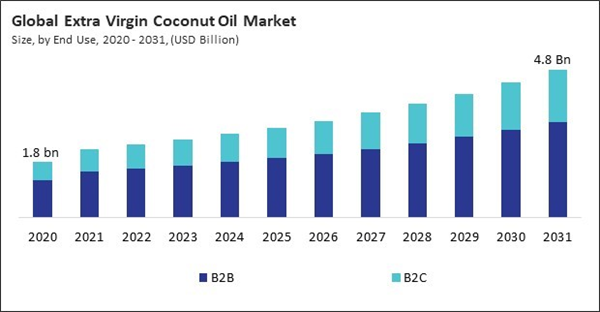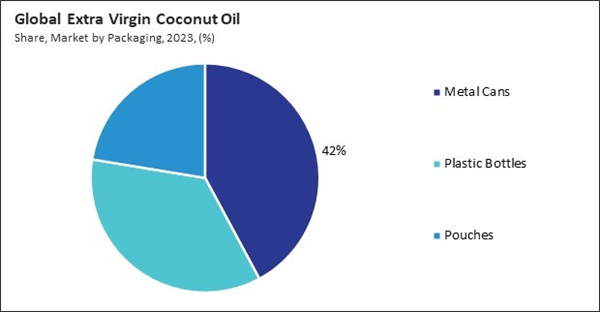The Global Extra Virgin Coconut Oil Market size is expected to reach $4.8 billion by 2031, rising at a market growth of 8.4% CAGR during the forecast period. In the year 2022, the market attained a volume of 1,146.59 hundred tonnes, experiencing a growth of 13.5% (2020-2023).
As consumers in the Asia Pacific region embrace their cultural heritage and traditional food ingredients, there is a growing preference for EVCO due to its superior quality and health benefits. Thus, the Asia Pacific region acquired 36.5% revenue share in the market 2023. In the terms of volume Asia Pacific region attained a volume of 438.19 hundred tonnes in the market 2023.Urbanization in China has led to changes in dietary preferences, with urban consumers increasingly seeking healthier and more diverse food options.
The increasing adoption of plant-based diets and lifestyles drives demand for plant-based alternatives to animal-derived products. EVCO, derived from coconuts, is a popular plant-based fat source used in cooking, baking, and frying.
Additionally, Consumers may be more open to trying and integrating EVCO-based products into their regular routines, leading to market diversity and expansion. Hence, higher level of disposable income has been a pivotal factor in driving the growth of the market.
However, Price volatility creates uncertainty for consumers, decreasing confidence in the EVCO. Fluctuating prices may deter consumers from purchasing EVCO products, as they may perceive them as less reliable or too expensive. Reduced consumer confidence can lead to lower demand for EVCO, negatively impacting market growth. Thus, high price volatility can slow down the growth of the market.
As consumers in the Asia Pacific region embrace their cultural heritage and traditional food ingredients, there is a growing preference for EVCO due to its superior quality and health benefits. Thus, the Asia Pacific region acquired 36.5% revenue share in the market 2023. In the terms of volume Asia Pacific region attained a volume of 438.19 hundred tonnes in the market 2023.Urbanization in China has led to changes in dietary preferences, with urban consumers increasingly seeking healthier and more diverse food options.
The increasing adoption of plant-based diets and lifestyles drives demand for plant-based alternatives to animal-derived products. EVCO, derived from coconuts, is a popular plant-based fat source used in cooking, baking, and frying.
Additionally, Consumers may be more open to trying and integrating EVCO-based products into their regular routines, leading to market diversity and expansion. Hence, higher level of disposable income has been a pivotal factor in driving the growth of the market.
However, Price volatility creates uncertainty for consumers, decreasing confidence in the EVCO. Fluctuating prices may deter consumers from purchasing EVCO products, as they may perceive them as less reliable or too expensive. Reduced consumer confidence can lead to lower demand for EVCO, negatively impacting market growth. Thus, high price volatility can slow down the growth of the market.
By End Use Analysis
On the basis of end use, the market is segmented into B2B and B2C. The B2C segment covered a 33.4% revenue share in the market in 2023. In 2023, the B2C segment attained a volume of 359.83 hundred tonnes in the market. The increase in e-commerce platforms has facilitated consumer access to various EVCO products from suppliers and brands.By Packaging Analysis
Based on packaging, the market is categorized into metal cans, plastic bottles, and pouches. In 2023, the metal cans segment captured 42.2% revenue share in the market with maximum revenue share. Metal cans provide excellent protection against light, air, and moisture, helping to preserve the freshness, flavor, and quality of EVCO.By Type Analysis
By type, the market is bifurcated into organic and conventional. The conventional segment acquired 33.1% revenue share in the market in 2023. In the terms of volume, conventional segment attained a volume of 454.94 hundred toones in the market 2023. Conventional EVCO is prized for its culinary versatility and flavor profile, making it a staple ingredient in many cuisines and recipes.By Regional Analysis
Region-wise, the market is analysed across North America, Europe, Asia Pacific, and LAMEA. In 2023, the North America region acquired 27.2% revenue share in the market. North American consumers increasingly prioritize health and wellness, leading to a growing interest in natural and organic products.List of Key Companies Profiled
- Nutiva, Inc.
- Nature's Way Products LLC (Dr. Willmar Schwabe GmbH & Co. KG)
- Garden of Life
- Forest Essentials
- MaxCare
- Barlean's Organic Oils, LLC
- Spectrum Organic Products LLC (Hain Celestial Group)
- Celebes Coconut Corporation
- Healthy Traditions, Inc.
- PT.Universal Coco Indonesia
Market Report Segmentation
By End Use (Volume, Hundred Tonnes, USD Billion, 2020-2031)- B2B
- B2C
- Metal Cans
- Plastic Bottles
- Pouches
- Organic
- Conventional
- North America
- US
- Canada
- Mexico
- Rest of North America
- Europe
- Germany
- UK
- France
- Russia
- Spain
- Italy
- Rest of Europe
- Asia Pacific
- China
- Japan
- India
- South Korea
- Australia
- Malaysia
- Rest of Asia Pacific
- LAMEA
- Brazil
- Argentina
- UAE
- Saudi Arabia
- South Africa
- Nigeria
- Rest of LAMEA
Table of Contents
Chapter 1. Market Scope & Methodology
Chapter 2. Market at a Glance
Chapter 3. Market Overview
Chapter 4. Global Extra Virgin Coconut Oil Market by End Use
Chapter 5. Global Extra Virgin Coconut Oil Market by Packaging
Chapter 6. Global Extra Virgin Coconut Oil Market by Type
Chapter 7. Global Extra Virgin Coconut Oil Market by Region
Chapter 8. Company Profiles
Companies Mentioned
- Nutiva, Inc.
- Nature's Way Products LLC (Dr. Willmar Schwabe GmbH & Co. KG)
- Garden of Life
- Forest Essentials
- MaxCare
- Barlean's Organic Oils, LLC
- Spectrum Organic Products LLC (Hain Celestial Group)
- Celebes Coconut Corporation
- Healthy Traditions, Inc.
- PT. Universal Coco Indonesia
Methodology

LOADING...










